Share this
What’s a Software Suite? 5 Ways it Differs from PLM
by Surefront on Feb 10, 2023 12:35:39 PM
Home > Blog > What's a Software Suite? 5 Ways it Differs from PLM
Table of Contents
- What is “Agile Product Lifecycle Management?”
- Traditional PLMs focus on stage 1-4
- What are Software Suites?
- 5 Ways We Go Beyond Product Lifecycle Management
- Looking Forward: What’s Next from Surefront?
Surefront is a Unified Product Collaboration Platform with PIM, CRM, and PLM solutions. It's a centralized data home where stakeholders can freely share product information and assign access permissions. Most integrations are supported in Surefront, but none are needed. Our articles often focus on one aspect of our unified PIM, PLM, and CRM platform. With Surefront, each solution seamlessly works together to achieve a guaranteed 10x ROI for every customer.
Determining the right PLM software investment for your business is a complex proposition. It can take months to learn to decode industry terminology. It takes just as long to sift through all of the retail solution providers claiming that their software suite is the one that will turn your business into the next Amazon. But what are the advantages of unified software suites over traditional PLMs?
There’s a reason that retail investments in the product lifecycle management market are booming. At the advent of the pandemic in 2020, many retail teams realized they lacked the grassroots agility needed to adapt their operation in the necessary timeframe. Whether they needed to provide BOPIS, curbside pickup, same day delivery, or to find new buyers/suppliers, most found they didn’t have the infrastructure in place to provide it without a serious technology investment that would take months to onboard.
It was in this environment that the transparency, control, visibility, and collaboration offered by PLM software emerged as a competitive advantage for retailers. And demand for agile product lifecycle management solutions hasn’t slowed since.
What is “Agile Product Lifecycle Management?”
Let’s look at the numbers. The global product lifecycle management market grew at a compound annual growth rate (CAGR) of 7.3% from $35.37 billion in 2022 to $37.94 billion in 2023. Impressive growth, right? Not once you put it in context. Let’s skip a few years ahead… the product lifecycle management market size is expected to hit a CAGR of 7.9% to skyrocket up to $51.38 billion by 2027.
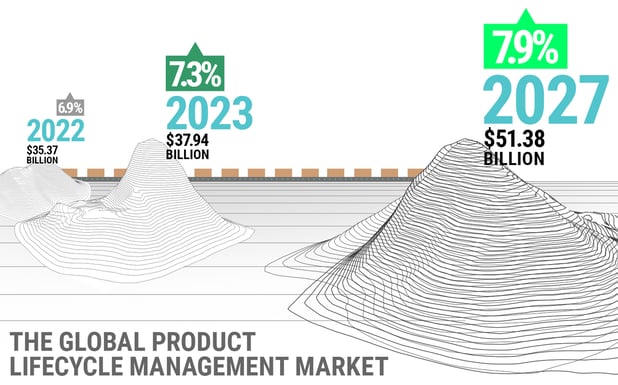
Product lifecycle management software works well as a standalone, but lacks the agility of a unified software suite. Surefront wanted to provide enhanced agility to suppliers and retailers that use our software in the wake of the Covid-19 pandemic. Physical stores hit a stalemate and retail teams needed to pivot faster than ever to provide customers with BOPIS, curbside pickup, and online catalogs in record time.
We identified an opportunity to greatly reduce the residual clerical work left over by traditional PLM solutions by building out our software suite, and we grabbed it by the horns. In the past three years, we’ve added Product Information Management (PIM) and Customer Relationship Management (CRM) functionalities, so the term “agile PLM software” alone no longer covers everything that our platform can do.
Education is the basis of every informed decision. In this article, we’ll educate you on the various applications of PLM software to ensure that you find the right unified solution for your needs. We’ll go over:
- The traditional functionalities of PLM software.
- The true definition of a “software suite.”
- 5 ways Surefront goes beyond old school PLMs.
- What’s next from Surefront.
Ready to understand complex retail software concepts and terminology? Want to know about the advantages of software suites? Let’s get into it.
Traditional PLMs focus on stage 1-4
You can’t talk about the difference between Surefront’s Software Suite and traditional PLMs without first defining the functionalities of legacy systems. Traditional PLMs focus on the front end of the product development and distribution process, specifically phases 1 through 4. These include:
- Concept or Ideation
- Design
- Production
- Distribution
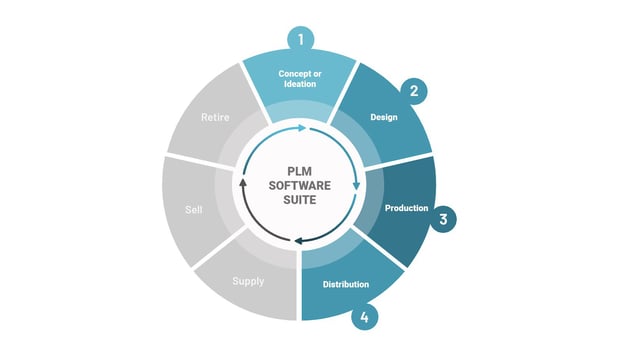
PLM software helps manage product information throughout the production and distribution process, so it’s often confused with product information management (PIM). In actuality, however, product information management (PIM) software and PLM software are on opposite sides of the data management spectrum.
PIM software is focused on data needed for marketing, such as: visual assets, customer data, design specifications, and financial data. Traditional PLM software, on the other hand, focuses on the data needed for production and B2B distribution. Using a traditional PLM can certainly help retail teams internally manage product information and prepare data for external stakeholders. But sales and marketing teams often need fast access to product visuals and design specifications to solidify sales. With traditional PLMs, sales and marketing teams still can't access the data they need.
Another issue with traditional PLM software is that it doesn’t enable retailers to integrate data from external vendors and suppliers. The ability to interface with external stakeholders is critical at each phase, as you will set goals and KPIs along every benchmark to streamline workflows.
Take the ideation phase, for example. You’ll need to be able to see: what raw materials are available, what the most cost effective components are for each product, which factories have the bandwidth to handle production, and possibly even whether your end consumer (be it retailer or supplier) has a need for that product.
Don’t want your team to get bogged down in emails, text communications, phone calls and Excel docs? Then they’ll need the ability to chat with all of your stakeholders on one unified platform. Most traditional PLM software solutions lack the ability to interface with anyone outside of your organization, or tools to facilitate the sales process.
What are Software Suites?
At this point you’re probably wondering, “what are software suites?” Hubspot defines a software suite as “A collection of applications and computer programs that have similar user interfaces and integrate with each other.” In the retail industry, this usually means a set of programs that are designed to tackle a similar phase in the production process. Software suites have a few core advantages over traditional PLM software:
-
They address multiple phases of the product lifecycle, not just steps 1-4.
-
Software suites prevent siloed data, so your information is more easily accessible by those that need it.
-
You only have to deal with the delay of one singular setup and implementation process.
-
You’ll pay less for a unified software solution than by buying features separately.
-
It’s easier and faster to train your team on one platform than many.
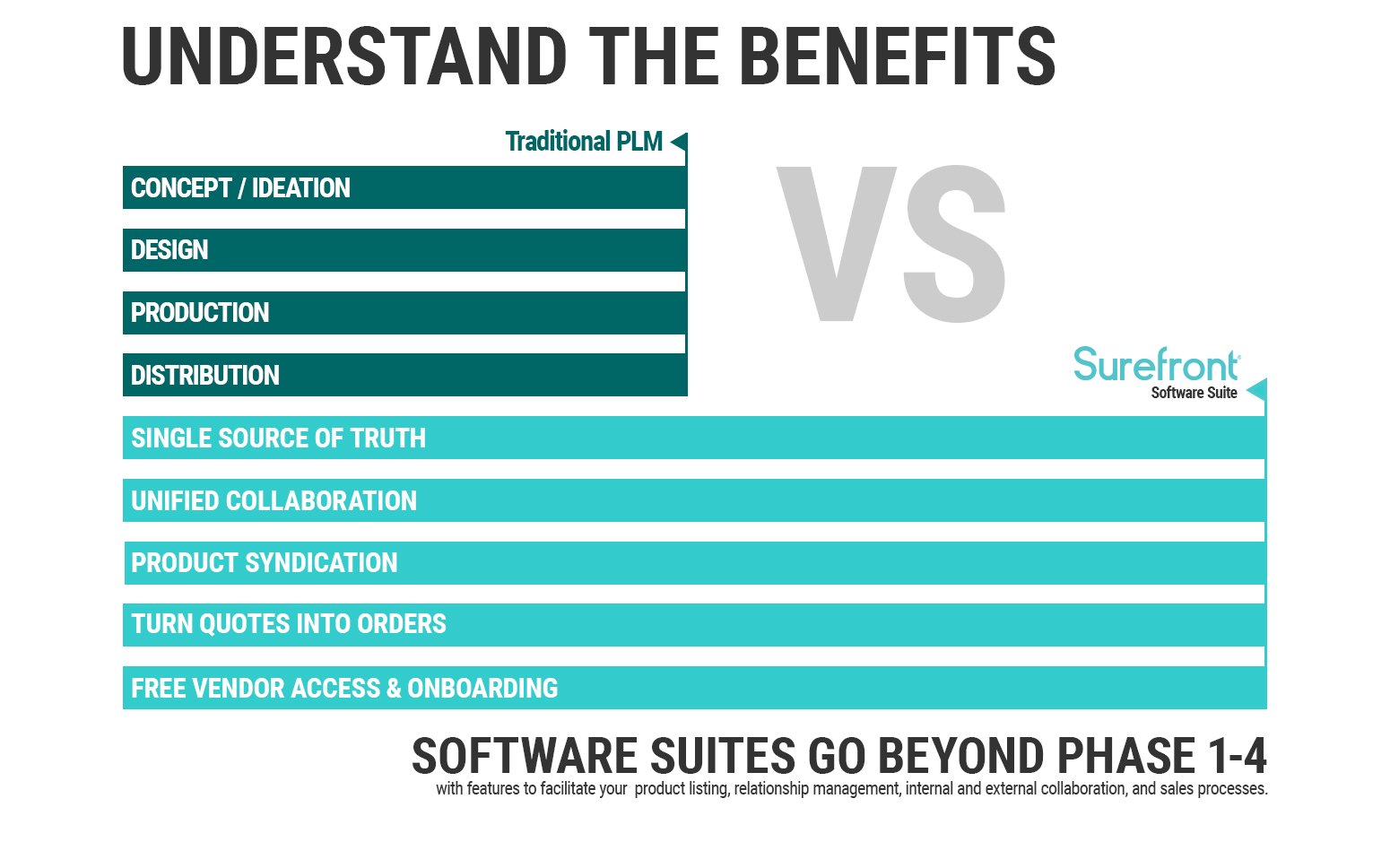
So, what do we mean when we refer to Surefront's unified platform as a “software suite?” We’ve added so many features to facilitate the production and sales processes that no single software term still encapsulates all that we do. You can’t create agility without a unified product collaboration platform. That’s why, since Surefront’s inception, we’ve been building out our platform to respond to the needs of the brands, suppliers, and retailers that we service.
With Surefront, you get the advantages of a software suite without the hefty price tag. All of your information is stored in one easy to access platform. In the next section, we’ll look at the exact features Surefront offers that go beyond traditional product lifecycle management software…and what they can do for your business.
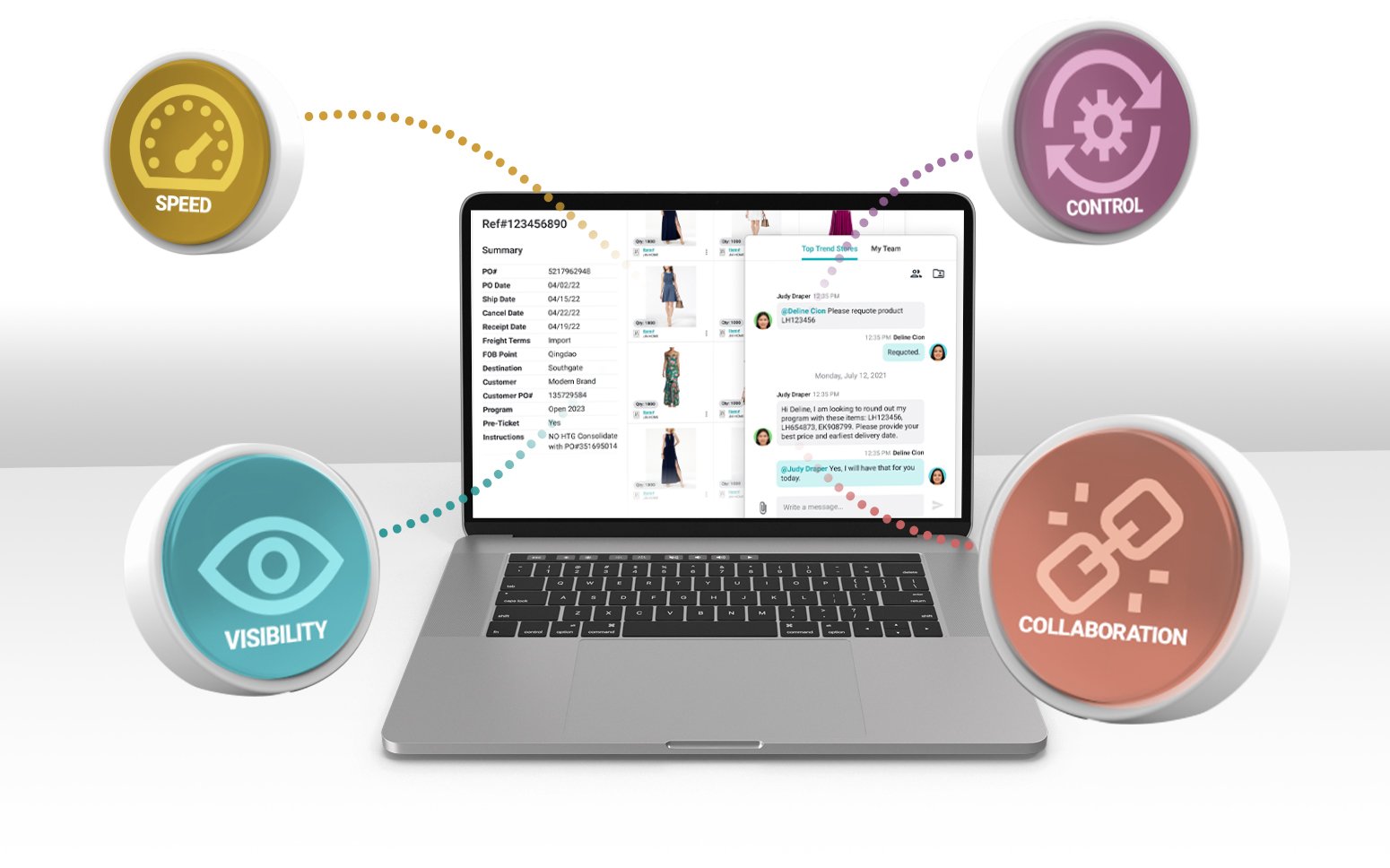
5 Ways We Go Beyond Product Lifecycle Management
“Agile product lifecycle management” is the buzzword du jour. However, the agility of any PLM software is limited not only by how easily that system shares information with the rest of your software solutions; the agility of your PLM is also limited by how easily you can use it to collaborate with external entities.
It takes product designers, buyers, suppliers, the C-suite, factories and all of the people in between to bring a single product to market. The issue is, most PLM software is only built to facilitate communication within your organization. Although inter-organizational communication is important, it comprises but a fraction of the collaboration capabilities required to bring products to market successfully.
Surefront was invented to address the comprehensive communication needs of the retail industry. Clients often call us a "software suite" due to the diverse applications we offer. Our focus is on addressing real life collaboration between internal and external stakeholders. Let’s take a look at where Surefront Unified Collaboration Management Platform goes beyond traditional PLM software to give your team the real world features they need to excel.
#1 - SmartCatalog is a single source of truth
Most people on retail teams don’t have access to the necessary product data to do their jobs effectively. Nor do they have proficiency in ERP systems that have been traditionally to house product data. If you don’t want to see your team bogged down by disparate systems and means of communication, Surefront’s SmartCatalog feature has you covered.
SmartCatalog is the single source of truth for all product data. Not just product data housed within your organization, either. You can easily select and export/import product data, images, and sticky notes from our SmartCatalog to any stakeholders outside of your organization. Clients love the robust product visuals in SmartCatalog because they can always see the product in question, which helps to drive sales.
#2 - Unified collaboration for all stakeholders
Siloed data wastes employee’s time, which reduces both productivity and profits. But siloed data was once the gold standard for the retail industry. Teams used to use disparate forms of communication to collaborate, review products, send and receive quotes, and/or negotiate pricing with external stakeholders. Bogged down by Excel documents, email threads, text chains and phone calls, teams could only scratch the surface of their potential productivity.
Surefront’s “many to many” collaboration platform helped JIA Home achieve a 40% shorter production cycle. By enabling sales teams to send and receive quotes from 3rd-party partners without ever leaving the platform, Surefront liberates them from unnecessary clerical work. Product orders that once took weeks to confirm take just minutes with Surefront’s agile product lifecycle management-based software suite.
#3 - Product syndication automatically publishes data to eCommerce sites
Every eCommerce site has its own set of specifications for how product data is presented on their platform. There’s little interoperability between how to add products to different selling channels. So, if you need to add products to multiple online catalogs, you’ll face a time consuming process rife with opportunities for human error. This isn’t an efficient or cost effective solution. We discovered a better way.
Surefront now offers product syndication, which means that products are automatically published to all of the eCommerce catalogs you choose. Each product listing is uniquely customized to fit every site’s unique specifications. So you can enter the data once and, in just a few clicks, customize your product listing for every site where you have a presence.
#4 - Turn quotes into orders/finalize orders
Is the back-and-forth necessary to generate quotes and finalize orders a monstrous time suck for your retail team? Quotes within Surefront are interactive, so you can easily communicate back and forth until everyone is on the same page. Once all stakeholders confirm the final terms of a quote, it can instantly be turned into an order with a single click.
Buyers immediately have all the information they need – products ordered, robust visuals, quantities, components, unit cost, freight information, margins, and more – in one easy to read purchase order. With Surefront, your final order is always error-free, has clear terms & conditions, and all the right players have agreed upon it. What could your team do with the time they get back from 10X faster quote customization?
#5 - Free vendor access and onboarding
Surefront is a no-code development platform. This means you can activate applications, develop new capabilities, and access services without having to write a single line of code. But that’s not all. Our unified product collaboration platform integrates with ERP and most other current systems, so you can keep your business running while you upgrade. Onboard your whole team onto Surefront in under 3 months!. We even offer a US-based customer service team that will help guide your setup and resolve any issue you may have within 24 hours.
But that’s still not all. During your onboarding process, we give each of your vendors a free Surefront license. Vendors gain access to a limited feature set and are able to receive support from our CX team. In fact, our platform has a 95% vendor adoption rate. We allow all of our customers to invite their partners to use Surefront, whether or not they have their own Surefront account. Whereas other platforms with PLM tools also offer this feature, the big difference is the way we do it: vendors get their own login and their own account. So, if they have another retailer they work with who also uses Surefront, they have their product information in the system.
Looking Forward: What’s Next from Surefront?
Surefront knows that it's the shared mission of retailers, brands, and manufacturers to get consumers the right product, at the right price, at the right time –– we also know that each stakeholder has to work together to make this happen. Our platform is the only tool with patented technology to help retailers, brands, and manufacturers collaborate seamlessly to achieve their shared mission. That’s because we’re the only tool built by the retail industry, for the retail industry.
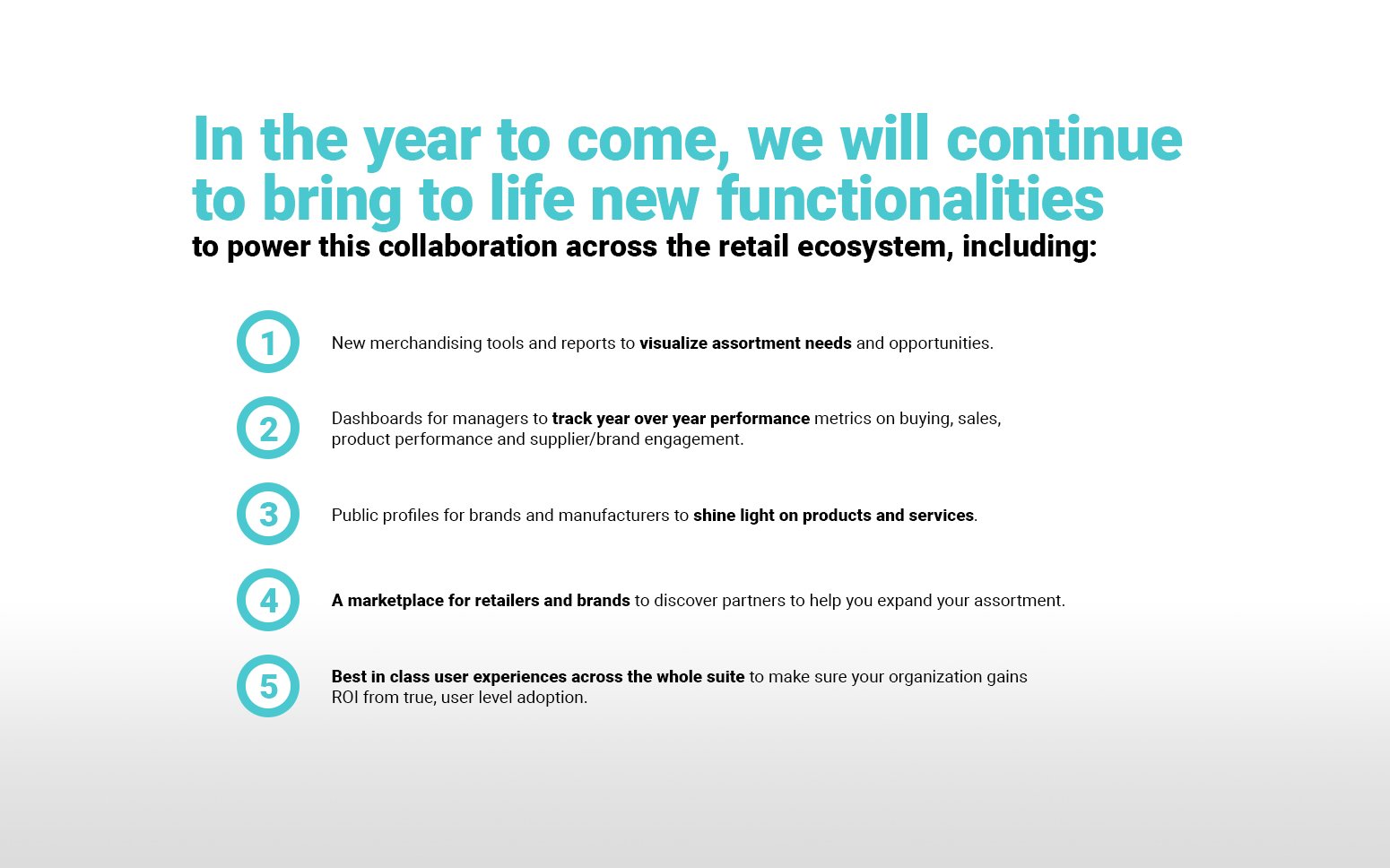
At Surefront, evolution is our imperative. We will continue to test & learn, adding in demand custom features to help our clients save time, generate revenue, and improve employee satisfaction/retention. But an agile product lifecycle management solution that packs the heavyweight data management punch of PIM is just one of many of the competitive differentiators of our unified product collaboration platform.
Share this
- PLM Software (36)
- PIM Software (29)
- Apparel & Fashion (20)
- Trending Topics (20)
- Merchandising (16)
- CRM Software (13)
- PLM Implementation (11)
- Catalog Management (6)
- Tech Packs (6)
- PLM RFP (5)
- Success Stories (5)
- Sustainability (5)
- Data Import (4)
- Line Sheet (4)
- Luxury Goods & Jewelry (4)
- Product Development (4)
- Retail (4)
- Supply Chain (4)
- Category Management (3)
- Home Furnishings (3)
- Wholesale (3)
- Consumer Packaged Goods (CPG) (2)
- Cosmetics (2)
- Data Export (2)
- Health & Beauty (2)
- RFQ & Quote Management (2)
- Consumer Electronics (1)
- Import & Export (1)
- Industry Events (1)
- Inventory Management (1)
- Pet Stores (1)
- Purchase Orders (1)
- Report Builder (1)
- Textiles & Raw Materials (1)
- Unified Solution (1)
- Vendor Management (1)
- Visual First (1)
- White Paper or Case Study (1)
- workflow (1)
- October 2025 (3)
- September 2025 (3)
- August 2025 (4)
- April 2025 (4)
- March 2025 (3)
- January 2025 (8)
- December 2024 (5)
- November 2024 (3)
- October 2024 (5)
- September 2024 (6)
- August 2024 (2)
- July 2024 (1)
- June 2024 (3)
- May 2024 (4)
- April 2024 (5)
- March 2024 (3)
- February 2024 (2)
- December 2023 (4)
- September 2023 (2)
- August 2023 (5)
- July 2023 (3)
- June 2023 (2)
- May 2023 (2)
- April 2023 (4)
- March 2023 (5)
- February 2023 (3)
- January 2023 (5)
- December 2022 (4)
- November 2022 (3)
- October 2022 (4)
- September 2022 (5)
- August 2022 (4)
- July 2022 (2)
- May 2022 (1)
- February 2022 (1)
- January 2022 (1)
- September 2021 (1)
- May 2021 (1)
- April 2021 (1)
- February 2021 (1)
- May 2020 (1)
